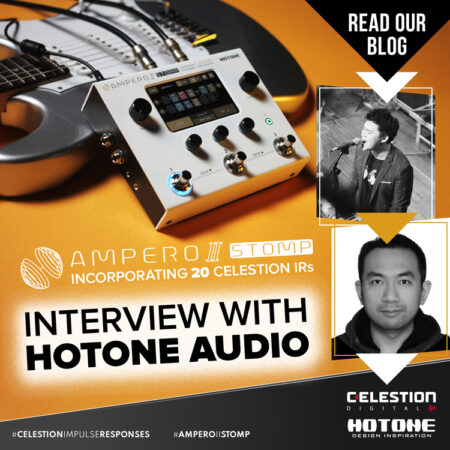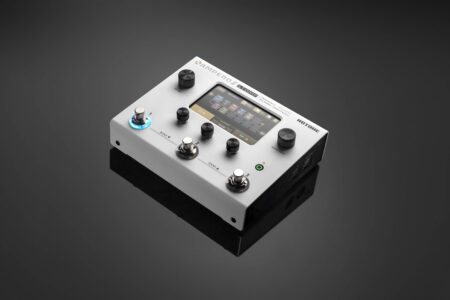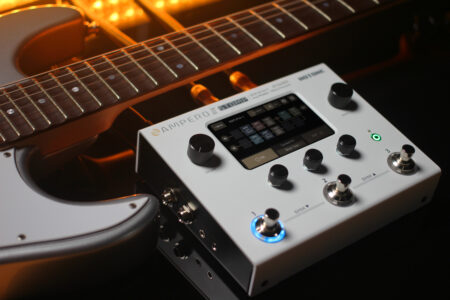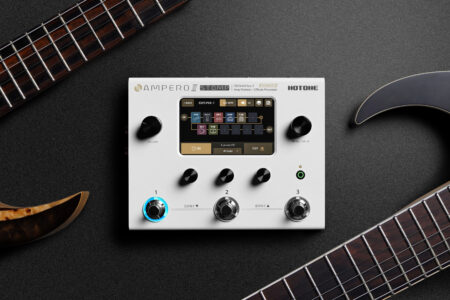 In our latest interview, we have the pleasure of speaking with Tom Liu and Bow Xiong from Hotone Audio – following the recent release of their new Ampero II Stomp Pedal – which incorporates 20 authentic Celestion IRs.
In our latest interview, we have the pleasure of speaking with Tom Liu and Bow Xiong from Hotone Audio – following the recent release of their new Ampero II Stomp Pedal – which incorporates 20 authentic Celestion IRs.
Hi Tom and Bow, great to speak with you today! Please can you tell us a bit about yourselves and your roles at Hotone Audio?
Tom I’m product manager here at Hotone and I’m in charge of product development – I define the direction of the product plan, the roadmap, and also the details of the product too. I have been working at Hotone Audio for approximately six years. I’m an electrical engineer and have lots of experience in the industry.
Bow – I’m in charge of PR at Hotone. Working here is a dream job for me, providing these great pieces of gear to the musicians I admire! I have been here nearly a year now; it’s a really cool place to work – regardless of where you’re from or your professional background, everyone here is fanatical about music.
So, tell me how you got to developing the Ampero II Stomp?
Well, this dates back to our first generation of the Ampero, which was released two years ago – this product was a bigger one, with a foot pedal in it, and it was a great success. We’ve gained lots of positive feedback from the market and then we asked all our customers, “what would you like to see next?”
What was the process like for gathering that feedback?
We reached out on social media, as well as our other social media services and groups we have in China. Internationally we use things like Facebook and Twitter, and domestically we use things like QQ.
We collected the feedback from them and, originally, what we expected they would want is a bigger model – we were supposed to make a truck for them! But actually, it turns out they wanted a Ferrari, not a truck so-to-speak. That’s why we decided to make the second generation a little bit smaller, this time. If you compare the Ampero II to the first generation, this one is actually smaller – it only has three foot switches and doesn’t have the foot pedal, but we beefed it up on the inside. It has almost double of everything in it, so that’s how we ended up with the Ampero II Stomp.

Tell me a bit about the benefits of the Ampero II Stomp being smaller than the first generation. Obviously, it’s easier to carry around for gigging and things like that, but what are the other benefits?
It sounds funny, when we think about the second generation product the customers’ said, “what you could do, to improve the product, is take out the special foot pedal”. They said, “we don’t need it anymore!”. One of their biggest questions was, “why would I need this heavy foot pedal that’s space-costing?”
That’s when we realised that sometimes addition and subtraction matter equally.
Cool! So as a result of your customers’ feedback you’ve streamlined the product and made it more efficient and ergonomic for the user?
Absolutely.
So, this really is an easy product for a musician to use. Would you say it’s suitable for any level of experience, from beginner through to advanced musicians?
Starting from the first generation, one of the reasons we added the touch screen to a guitar effects pedal is that there is always a learning curve for multi-effects. We wrote a 180-pages user’s manual, which is more like a book and if you really want to master our device, you will have to read through the manual a little bit. But we questioned ‘why?’ It’s 2021 and no one’s going to read the manual for an iPhone, for example, but they can still comfortably use one.
So we added the touch screen, so that it’s as easy to use as a smartphone with a user-interface that people are familiar with already.
This makes it very user-friendly for beginners who can get started straight away! Then they can progress on to the more advance functions and perhaps dive into the user manual a little.
We wanted to make sure we covered all bases for our customers. If you are an advanced user and you really want to delve into the details of the product, we have something for you. But if you just want to grab a guitar and play, we have 99 factory presets for you, so you don’t have dive into altering any parameters by yourself if you don’t want to – you can just try all the presets which we have provided and then you’re good to go.
It’s a product that any can pick up, from beginners to advanced musicians, and get a great sound easily. Would you say that’s the case?
Yes, for sure.
What does your ideal customer profile look like? Where are the majority of your customers, on a scale from beginner to professional musicians?
Our major customers are those who are already comfortable with the idea of a pedalboard – they might already have 10 pedals. They carry that pedal around with them, whether they’re playing at home, in the studio or on stage and they want a simple solution.
Our Ampero II Stomp replaces many of the pedals on their pedalboard. We have collected a lot of information on our current ideal users, to see how they’re using our products, and we found that most of the customers who used the first generation of the Ampero had ditched all their other pedals because they just wanted to use one simple solution.
 That makes sense – a lot of people don’t want to store or carry around extra equipment or take it with them every time they perform.
That makes sense – a lot of people don’t want to store or carry around extra equipment or take it with them every time they perform.
That’s right. So, our main customers already have a good level of knowledge of guitar effects. They’re actually very picky, because they’ve already fiddled with all kinds of different pedals! They know what they want, so they already have an established taste when it comes to sound quality and effects.
What they’re looking for, is just one pedal that does it all.
Most of our customers are guitarists, but our product range is also designed for keyboard players and electronic music producers and performers if you’re using synthesisers. We have customers who use synthesisers and also use our pedal, which is actually designed for guitar!
We also have customers who are saxophone players, electric violin players – all kinds of musicians!
It sounds incredibly versatile!
Absolutely. Versatility is one of the main selling points of the Ampero II Stomp.
How long has it taken you to develop the second generation of the Ampero?
The first generation was launched 2-3 years ago, and as soon as we finished the design for the first generation Ampero, we started working on the next generation. We already had a very long roadmap and, now that the second generation has been launched, we’re actually creating the third generation already!
It’s in the pipeline – To plan is one thing but executing is another. When you plan something, you don’t have to stick to every process you initially design. You can change, and pivot based on customer needs or trends. Just like how the Ampero II evolved in comparison to our initial vision of a bigger second generation, plans can always change.
Are there lots of people involved in the design process, in terms of getting the product from the idea stage, through to sign-off when you can start the build?
We have an R&D team of around 30 engineers, as well as other musicians working here and a production team, but it takes all of the departments working together to bring a product to market.
If someone was new to Hotone Audio’s products and Celestion IRs, how would you define the Ampero Stomp II?
I would say that we have designed the product to be very simple, in terms of the IR files and particularly Celestion’s IR files, we have designed it in a very simple way.
Originally, we thought we needed to provide lots of different tunings for the IR files, so that the users could change the microphone and microphone position – but we decided to scrap this because, as I mentioned before, our main user just wants to take the pedal, plug in their guitar, and use it straight away. One thing that we have done, especially in terms of the IRs, is that we have left it very simple. We have made sure that all of the IRs already have a very good configuration, you don’t need to think about ‘ok, what do I need to do first?’ you can just plug in and play.
Is that what you find the market demanding?
Yes, you could say that people are becoming lazier! However, it’s up to us to meet the demands of the customer – It’s Marketing 101.
Absolutely. We’ve discussed many of the key selling points of the Ampero II Stomp, but is there anything else you would like to add about the main benefits of the product?
One thing I’d like to point out is the core technology of the Ampero series, which is called CDCM HD (Comprehensive Dynamic Circuit Modeling High Definition) and F.I.R.E. (Field Impulse Response Enhancement). This is our own unique technology that our musicians feel like is the best way to go.
Sounds great! Could you tell me a bit more about that?
As we just mentioned, we have two core technologies:
- White Box Modeling, which is the CDCM technology.
- Black Box Modeling, which is the F.I.R.E technology. This is the part which relates to Celestion IRs.
I don’t want to bother you with all the technical details, but you could think of it like this: the White Box Modeling is where we analyse the circuit and internal structure of anything we are going to simulate. We try to reproduce each component, the relationship, and reactions between those components, and that’s one way of modeling.
Another way of modeling is called Black Box Modeling, which means, ‘I don’t know what I’m trying to simulate, and I don’t care, what I need to know is the impulse response’ so if I give an input to this system, I get a response (which is the IR). I can then use the IR file and the convolution to reproduce the sound. So that’s the Black Box Modeling.
So, actually, the Ampero Stomp II is Grey Box Modeling – the combination of white and black.
That’s really interesting! Would you say this approach is completely unique to your product?
That’s right, the Ampero is the first product to combine White and Black Box Modeling in a single product – but it won’t be the last one.
Besides all the technology and algorithm improvements, when we designed this product, we thought it would be really cool for us to try something new and ‘stand on the shoulders of giants’ like they say, such as Celestion. These 20 Celestion IRs included in the Ampero II Stomp are some of the best surprises in this product for all the Hotone fans and Celestion fans. I think it’s one of the best decisions we made for this product.
We actually kept their inclusion a bit of a secret – we sent out testing units to our beta teachers and we put out some teasers through social media, but we kept the Celestion IRs quiet until the last minute – as our secret ingredient to the product!
What made you choose Celestion IRs to include with the Ampero II Stomp?
Everybody is after the legendary Celestion speaker cabinet tones, right? There are many other companies providing IR files for Celestion speakers, but why get them from anyone other than the most authentic provider?
We know that Celestion has spent a lot of resources and energy to make those IR files as perfect as possible. They have recorded them in the best conditions, using the most top-notch equipment with the most experienced producers, so we can immediately tell the difference between the IR files from Celestion and IR files, for Celestion speakers, produced by other vendors. The Celestion IRs are much clearer.
We know it’s a shortcut, but we’re proud of it!
Of course, it’s good business sense to use resources that are already available!
When using the Celestion pre-programmed IRs, users can just select the one they want?
Yeah. With the first generations we only allowed users to load one IR at-a-time, but now with the Ampero II Stomp users can combine and blend multiple IRs together. Just drag-and-drop and you’re good to go.
And for users who want to import their own Impulse Responses could you tell me a bit about that?
It’s very simple, actually. We have our own compatible software/editor for both Windows and MacOS, so all you need to do is connect your Ampero pedal to the computer.
You then just need to open the software and you will be able to see all the empty user IR slots available to you. Simply click on the slot and you can upload your impulse response file, or multiple files together. It’s very intuitive.
 How do you think the musical landscape has changed, over the last few years? We’ve seen a big increase in people moving towards the digital side of music gear in the last few years, and more people becoming interested in things like IRs and speaker responses. How about from your side?
How do you think the musical landscape has changed, over the last few years? We’ve seen a big increase in people moving towards the digital side of music gear in the last few years, and more people becoming interested in things like IRs and speaker responses. How about from your side?
Great question. I think guitar playing in general is making a comeback these days, especially in pop culture. Trends are very much cyclical – for example in the 1930’s to have a guitar solo in a song would be considered strange and unorthodox, but in the 1970’s it was one of the most recognisable aspects of popular music and in that period of time so many of the guitar heroes musicians look up to today were established in that period.
Then, at the turn of the millennium guitar playing sort of faded away again out of the mainstream, being replaced by synthesisers and electronic music – but now we feel like it’s making a comeback. It’s good for our guitar players and good for our companies (and other companies like us) in general. It’s a good trend to see developing, hopefully, over the next few years.
In terms of digital gear I think that, because of the technology improvements, I don’t feel too much difference between vintage gear and the newer digital gear. To me, the sound really doesn’t feel that different anymore and I think perhaps people aren’t realising it enough or are sticking to their old beliefs that the old-school gear must be superior. I think in the next few years, as our technology continues to move forward, more people will start to realise that new, digital gear can sound just as good. I think time will tell.
What would you say the benefits are of using a predominantly digital setup, in comparison to an old-school analog setup?
I think the biggest benefit is that you have a much lower opportunity cost – you don’t have to try everything you want, the old-school stompbox pedals are good stuff, but if you want to really know what sound they each produce you have to try them all, one by one. With a multi-effects processor you can try things as you please and save them to your custom slots with ease.
Thanks so much for your time today, is there anything else you’d like to add?
First of all, thanks for having us!
Also, we would like to say that we are very glad that we can work with Celestion on this product, and we are also looking forward to other collaborations in the future on other products too.
We have our own software plugin products too and we are also working on our own cabinet, and we have already started working with Celestion, using the physical speakers rather than IR files, so I think we’re going to have a very good relationship with Celestion going forwards.
To tell you a secret, 9 years ago when we started this company and when we entered the overseas market, we were reluctant to reveal our identity as a Chinese brand, at that time. We were worried about the stereotypes, but nowadays we don’t have that fear anymore and we can say that, in terms of the amp and cab simulation technology, we are already top notch in the world. It was a very good opportunity for us to work with Celestion and we would like to make it even better in the future!
Find out more about Hotone Audio and the Ampero II Stomp

